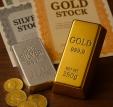Japan Between A Rock And A Hard Spot Part - IV
"Only Solution Is To Dump U.S. Treasuries and Buy GOLD!"
DISCLAIMER: You should be warned upfront the following hypothesis may only be the theory of the writer... and perhaps a select few. Although there is ample foundation for the idea, some critics will undoubtedly claim it to be a Financial Fairy-tale... albeit feasible. Nevertheless, there is indeed a logical basis for it.
A GLOBAL GOLD STANDARD
During the past several months numerous less important Central Banks have been selling off their gold reserves. Namely, Belgium, The Netherlands, Canada, Australia, and to a much lesser extent some Latin-American banana republics. More important than the suggested spurious rationale for the selling side, are the WHO AND WHY of the buying side. SOMEONE OR SOMEBODIES are methodically accumulating the noble metal.
Talk of a global gold standard in the last year has almost been non-existent. Nevertheless, this idea traveled through the pages of numerous market writers in early 1995. In fact the redoubtable Fed Chairman, Alan Greenspan was one those who spoke of the idea in that year.
Federal Reserve chairman Alan Greenspan is not the type to say "Good Morning" without a thorough examination of meteorological conditions. And if greeted with a "Good Morning," the inimitable Mr. Greenspan would characteristically answer in terms so nebulous as to leave the hapless greeter with the confused uncertainty of what season it is. So it is unlikely that his March 1995 endorsement of the Gold Standard was an innocent aside. To get some idea of where Mr. Greenspan is coming from, it is meaningful to reread Alan Greenspan's 1966 treatise, GOLD AND ECONOMIC FREEDOM - http://www.fame.org/fedwatch/Fedwatchb.htm It is his plain-English version of what he really thinks on the subject of the Gold Standard.
Is someone orchestrating a return to a global gold standard? Why would anyone want to return to the past and give value to the "barbarous relic?" Indeed, is it feasible? What would be the benefits accruing from a global gold standard.
Serious Economic and Financial Problems Abound Globally
Japan is waddling through deep financial mire. It is losing export competitiveness vis-a-vis a declining dollar parity. The Bank of Japan (BOJ) is suffering indigestion of too many US dollars as a percent of its total reserves (76%). Its financial markets are racked by scandals galore. Its banking system is rotten with unperforming loans to the tune of $400 to $600 billion. If that were not enough, it is buried in a sea of U.S. Treasury paper ($300 billion). And the proverbial straw may be the BOJ's minuscule gold reserves, which are a paltry 0.37% OF ONE PERCENT OF ITS TOTAL ASSETS. One might say the FRB of New York sweeps up more gold dust from its vault floors monthly... than the BOJ has in bar form in its vaults. On top of all these seemingly insurmountable problems, the Nippon economy is stagnant, forcing the BOJ to flood the world with YEN, and abolishing interest rates in its heretofore futile effort to jump-start business.
One of the qualifying conditions for the 1999 establishment of the EMU requires that certain European countries reduce their gold reserves. However, this seems to be a sticky point for several of the members. Staunch French skeptics would first sell the Louvre before its precious gold.
The U.S. has been financing much of its economic growth, and ALL of Wall Street's irrational exuberance via the inexhaustible supply of Treasuries, conveniently sold mostly to foreigners.
At first glance the above situations appear NOT to be inter-related. But, let's take a closer look with a view to see what mutual benefits all might enjoy if a global gold standard were again established.
As an interesting intellectual exercise, let us assume that indeed Chairman Greenspan and counter-parts are in fact studying the ramifications of a return to some sort of gold backing of the narrow money supply of the more industrialized countries. With the invaluable aid of data derived from IMF statistics, Greenspan's hypothetical train of thought might take the following course.
What Price Gold for the New Global Gold Standard?
The 64,000 ounce question is: "What percent gold reserve backing would be feasible?" 100% is out of the question. 10% would be too insufficient to harvest any noticeable benefit. And whereas 50% might eventually be the ideal level, 25% would obviously be more practical and attainable in the short-run.
| Data Derived from International Monetary Fund Statistics - | ||||
| Country |
Gold Reserves Million Ounces |
Gold Reserves Long Tonnes |
M-1 $ Billions |
$/Oz Gold Price @ 25% |
| USA | 261.8 | 8,143 | 1,231 | 1,176 |
| Germany | 95.2 | 2,960 | 496 | 1,303 |
| Switzerland | 83.3 | 2,590 | 79 | 237 |
| France | 81.9 | 2,546 | 288 | 878 |
| Japan | 24.2 | 754 | 1,657 | 17,118 |
| UK | 18.4 | 574 | 172 | 2,329 |
| TOTALS | 564.8 | 17,567 | 3,923 | 3,840 (A) |
Note (A): The average gold price for all six countries would be $3,840 ounce. However, Japan should be deleted to normalize the statistical data. Doing so produces an average gold price of $1,187 per ounce. Our example is rounded to $1,200 in order to simplify. It is rather apparent some adjusting of each participant's gold holdings must be implemented to conform to the Global Gold Standard based upon a 25% gold backing of the narrow money supply.
A "WHAT IF" SCENARIO -
Assume all six nations agree upon a 25% gold backing of each countriy's M-1 money supply, and that the average gold value, deleting the Japanese data as it skews the curve, should be $1,200 per ounce.
To initiate the new Global Gold Standard each country will have to buy or sell enough gold to meet the 25% gold coverage of its current M-1. Accordingly, the following table shows what each country must do in order to comply. Please note M-1 data are one year old.
| Country | Gold Reserves Million Ounces | M-1 $ Billions | 25% M-1 $Billions | Gold Req'd @$1,200 | Action To comply |
| USA | 261.8 | 1,231 | 308 | 256.7 | sell 5.1 mil. oz. |
| Germany | 95.2 | 496 | 124 | 103.3 | buy 8.1 mil. oz. |
| Switzerland | 83.3 | 79 | 20 | 16.7 | sell 66.6 mil. oz. |
| France | 81.9 | 288 | 72 | 60.0 | sell 21.9 mil. oz. |
| Japan | 24.2 | 1,657 | 414 | 345 | buy 321 mil. oz. |
| UK | 18.4 | 172 | 43 | 35.8 | buy 17.4 mil. oz. |
Based upon the hypothetical example, Japan would be required to purchase 321 million ounces of gold. Conveniently, almost 100 million ounces could be bought (OR SWAPPED FOR T-BONDS) directly from those countries required to sell in order to comply with the 25% gold reserve backing of the M-1 money supply. This begs the question. Is this financially feasible for the Empire of the Rising Sun? Obviously Japan would be buying gold at ever increasing prices. But let us assume the extreme case: that all 321 million ounces will be purchased at $1,200 (calculated per IMF data). The total outlay to make this gigantic gold purchase would "ONLY" be $385 billion. I say "ONLY" because of the following data from the Japanese economy.
Japanese financial flows per international sources is illuminating (please note data are one year old).
| Japanese Financial Flows | Dollar Amount | Gold Equivalent (A) |
| Long term bonds maturing Oct | $35 billion | 3,400 m.t. |
| Purchase foreign bonds 2Qrt | $49 billion | 4,800 m.t. |
| BOJ's dollar purchases 1995 | $60 billion | 5,800 m.t. |
| One year's household savings | $480 billion | 46,700 m.t. |
| Total Japanese Financial Flows | $624 billion | 60,700 m.t. |
(A) Valued at $320/oz.
m.t. denotes metric tonnes
The above Nippon annual financial flows clearly indicate they indeed have the capital clout to purchase 321 million ounces of gold for $385 billion - valued at $1,200 per ounce. However, it would be naive to believe the Japanese would pay $1,200 an ounce for the noble metal. Whereas the Japanese are known as big spenders when they really want something (i.e. real estate worldwide prior to 1989), they are too INSCRUTABLY astute to pay $1,200 an ounce for the yellow metal. The reason? They have a ace in the hole... or rather about 300 billion aces in the hole. The BOJ has approximately $300 billion of Uncle Sam's interest bearing paper (T-Bonds).
It does not take a financial genius to envision the BOJ SWAPPING Treasuries for gold at current prices. The purpose would benefit all, and conceivably implement a new GLOBAL GOLD STANDARD.
Benefits of a GLOBAL GOLD STANDARD -
A reasonable question is why should the world's financial powers go through all the trouble to establish a GLOBAL GOLD STANDARD? What possible mutual benefits would be achieved? This writer sees the following as productive ramifications of a new GLOBAL GOLD STANDARD.
- The world's major currencies would enjoy stability - especially the Yen/Dollar parity.
- Interest rates would remain low and stable.
- In consequence to #2, the U.S. stock market would continue to advance, and bonds would remain strong.
- Inflation would continue to be maintained at controllable levels.
- The Japanese economy would be stimulated via reflation.
- The Nikkei would continue to recover lost ground from its January 1990 all-time record peak or 39,000.
- The BOJ will have diversified its total reserves (now 76% US dollar denominated).
- Temporary U.S. debt relief - allowing the U.S. Treasury to float more T-Bonds to finance the operations of the U.S. government.
- The European countries who will sell gold to comply with the new GLOBAL GOLD STANDARD will have converted a non-income asset into a U.S. Treasury bond paying 6.5% annually. And, coincidentally, it helps some European nations to comply with the very stringent conditions of the EMU creation.
- Lastly, the stoic perseverance of the GOLDBUGS will have been finally and amply rewarded.
This writer has no doubt there will be those who feel our hypothesis is too far-fetched. But I would ask them the following questions:
- WHO IS BUYING ALL THE GOLD that the smaller Central Banks are selling? And why are they buying?
- Why have the great financial powers - like the six mentioned above - NOT SOLD ONE SINGLE OUNCE OF GOLD IN MANY YEARS?
- In view of Japan's many pressing problems, why would it not embrace this feasible solution to its economic and financial ills? They obviously have the bucks, ..so why not buy the cure?
Financial Fairy-tale ? ...methinks NOT!

















